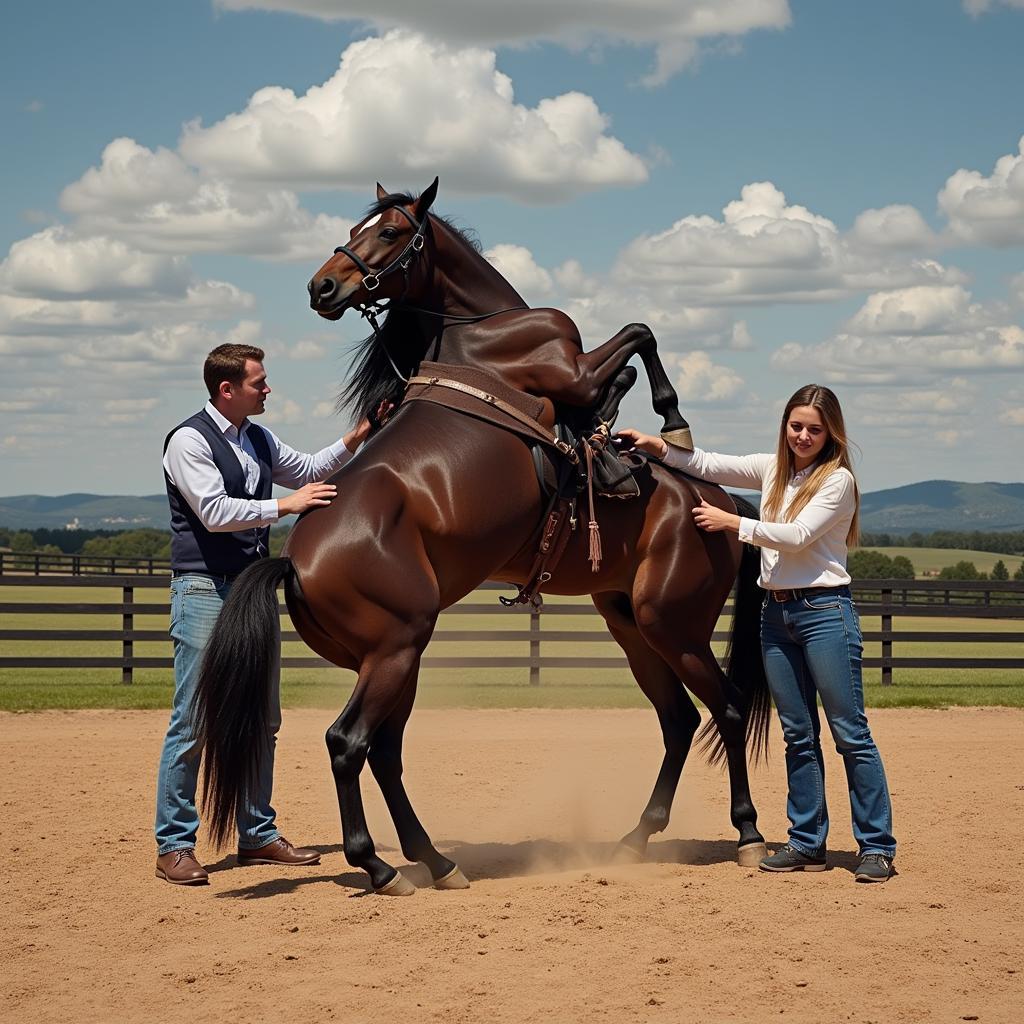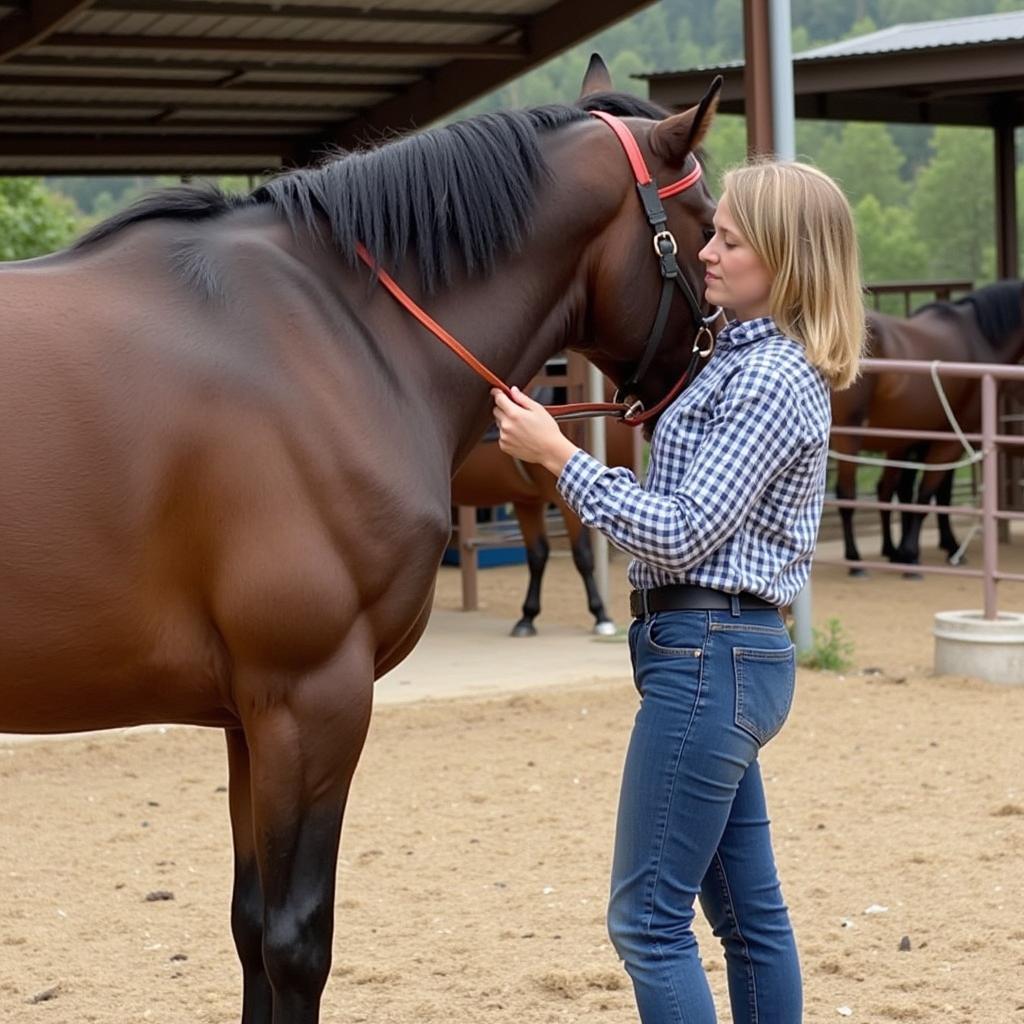Horse Hand Breeding is a time-honored practice that requires knowledge, patience, and a deep understanding of equine reproductive behavior. This guide will delve into the intricacies of hand breeding, providing valuable insights for breeders and horse enthusiasts alike. We’ll cover everything from preparing the mare and stallion to managing the breeding process and ensuring the well-being of both animals.
Understanding the Basics of Horse Hand Breeding
Hand breeding offers greater control over the breeding process compared to pasture breeding. It allows breeders to carefully select pairings, monitor interactions, and minimize the risk of injury. This method also provides valuable data for record-keeping, aiding in genetic management and improving breeding outcomes. Choosing to hand breed requires commitment and meticulous attention to detail, but the rewards can be substantial. It’s crucial to be familiar with the horse’s reproductive cycle and signs of estrus in the mare. This knowledge allows for optimal timing of the breeding process, maximizing the chances of conception. Are you ready to delve deeper into this fascinating aspect of horse care? Let’s explore the essential steps involved.
After evaluating the mare’s readiness, the next step is preparing the stallion. This involves ensuring the stallion is clean and healthy. Experienced breeders often use a teaser mare to confirm the stallion’s readiness to breed. This practice helps to avoid potential aggression or frustration during the breeding process. Handlers must be experienced and confident in managing both animals, prioritizing safety at all times.
 Preparing Mare and Stallion for Hand Breeding
Preparing Mare and Stallion for Hand Breeding
Preparing the Mare and Stallion
Proper preparation is paramount for a successful hand breeding. The mare should be clean and free of any debris around her genital area. Her tail should be wrapped or bandaged to prevent contamination during the breeding process. The stallion, too, needs to be clean, and his sheath should be inspected and cleaned if necessary. These hygiene measures are vital for minimizing the risk of infection.
Remember, safety is key. Always have experienced handlers present. Utilize appropriate restraining methods like halters and lead ropes to maintain control over both animals. Never underestimate the power and unpredictability of horses, even in a controlled environment. Proper restraint and handling techniques can prevent injuries to both the mare and the stallion. For specific guidance on keeping your horse’s water source pristine, see our guide on how to keep horse trough clean.
The Breeding Process
Once both animals are prepared, the mare is typically led to the stallion in a designated breeding area. The stallion is allowed to approach the mare, and the breeding process begins naturally. The handler’s role is to ensure the safety of both animals and guide the process as needed. Close monitoring is essential throughout the entire interaction. A clean, safe, and controlled environment is crucial for a successful breeding.
What are the signs that the breeding was successful? Observing the stallion’s behavior can offer clues, but ultimately, confirmation of pregnancy will require veterinary intervention later on. A veterinarian can perform an ultrasound or palpate the mare to confirm pregnancy.
 The Hand Breeding Process in Action
The Hand Breeding Process in Action
Post-Breeding Care
After breeding, both the mare and stallion should be carefully monitored. The mare should be allowed to rest and recover. Observing the mare for any signs of discomfort or infection is crucial in the days following the breeding. Regular veterinary check-ups are recommended to ensure the health and well-being of both animals. Interested in specific breeds? Check out our listings for miniature horses for sale in texas. If you are looking for a specific horse, consider a whisky white horse.
For those interested in other horse breeds, especially those from Europe, we offer resources like black forest horse for sale germany. We also have information on selecting the perfect team roping horse.
 Post-Breeding Care for Mare and Stallion
Post-Breeding Care for Mare and Stallion
Conclusion
Horse hand breeding is a delicate process requiring expertise and attention to detail. By understanding the intricacies of equine reproduction and following proper procedures, breeders can maximize the chances of a successful outcome. This comprehensive guide to horse hand breeding provides a solid foundation for navigating this intricate process. Remember, prioritizing the well-being of both the mare and stallion is crucial for a positive breeding experience.
FAQ
- How often should I breed my mare?
- What are the signs of estrus in a mare?
- How long does the hand breeding process typically take?
- What are the risks associated with horse hand breeding?
- How can I increase the chances of a successful breeding?
- What is the cost of horse hand breeding?
- When should I call a veterinarian after hand breeding?
Common Scenarios and Questions
-
Scenario: The mare kicks the stallion during the breeding attempt.
- Question: What should I do if the mare shows aggression towards the stallion?
-
Scenario: The stallion seems disinterested in the mare.
- Question: What can I do to encourage the stallion’s interest in the mare?
Further Resources
For more information on horse care and breeding, explore other articles on our website. You can also find information on related topics like horse nutrition and training.
Contact Us
For assistance with horse hand breeding or any equine-related inquiries, please contact us: Phone: 0772127271, Email: [email protected] or visit us at QGM2+WX2, Vị Trung, Vị Thuỷ, Hậu Giang, Việt Nam. We have a 24/7 customer support team.